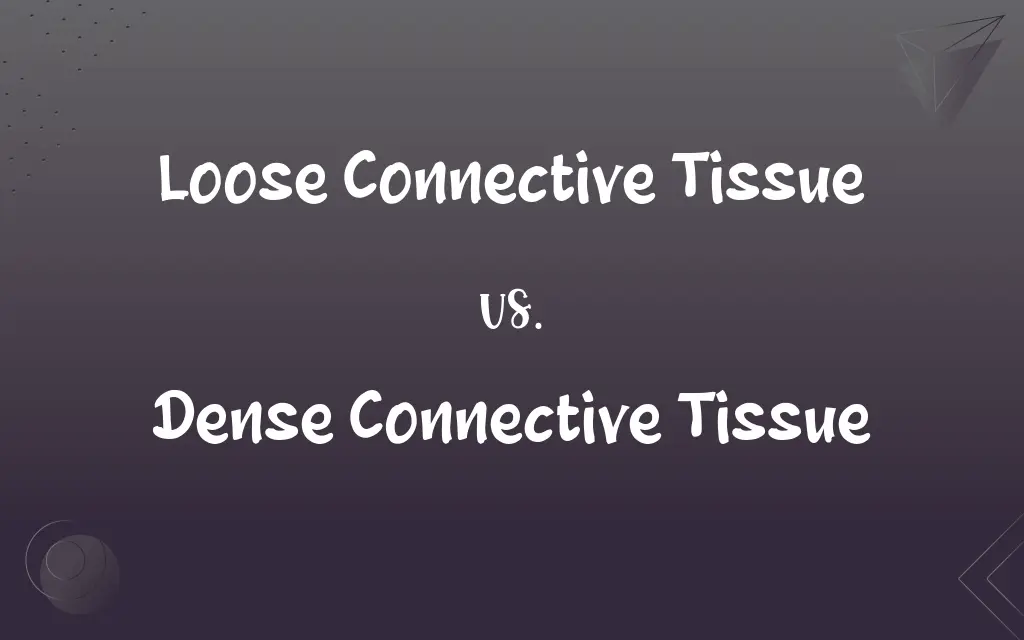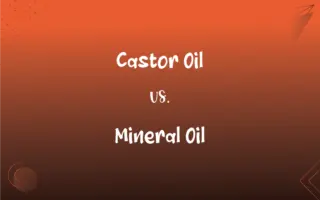Loose Connective Tissue vs. Dense Connective Tissue: What's the Difference?
Edited by Aimie Carlson || By Harlon Moss || Updated on October 19, 2023
Loose connective tissue has fewer fibers and more cells; dense connective tissue is packed with fibers with fewer cells.

Key Differences
Loose connective tissue is a type of connective tissue characterized by a relatively high cell count and fewer fibers. It provides support, elasticity, and nourishment to the surrounding structures. In contrast, dense connective tissue is rich in collagen fibers, providing strength and resilience.
While loose connective tissue is found in many parts of the body, including under the skin and around blood vessels, dense connective tissue primarily forms tendons, ligaments, and the deeper layers of the skin. These dense structures need to withstand mechanical stresses, explaining their compact nature.
The primary function of loose connective tissue is to bind tissues together, allowing flexibility and providing a cushioning effect. Dense connective tissue, due to its compact nature, offers limited flexibility but is incredibly robust, ensuring joints and muscles remain anchored securely.
Loose connective tissue and dense connective tissue both play crucial roles in the body's structural framework. However, while the former provides a supportive and nourishing environment, the latter offers stability and strength.
The body utilizes the properties of both loose connective tissue and dense connective tissue to function optimally. While loose connective tissue ensures that organs are held in place and remain well-nourished, dense connective tissue facilitates movement and provides resistance to external forces.
ADVERTISEMENT
Comparison Chart
Fiber Density
Fewer fibers.
Packed with fibers.
Cell Count
Higher cell count.
Fewer cells.
Function
Provides support and nourishment.
Offers strength and resilience.
Examples
Under the skin, around blood vessels.
Tendons, ligaments, deep skin layers.
Flexibility
More flexible.
Limited flexibility but high strength.
ADVERTISEMENT
Loose Connective Tissue and Dense Connective Tissue Definitions
Loose Connective Tissue
A tissue type providing elasticity and cushioning.
The presence of loose connective tissue makes our facial skin elastic.
Dense Connective Tissue
Tissue providing high strength and limited flexibility.
Ligaments, made of dense connective tissue, keep bones securely connected.
Loose Connective Tissue
Tissue with more cells and fewer fibers.
The loose connective tissue under the skin keeps it supple and nourished.
Dense Connective Tissue
A tissue type predominantly found in tendons and ligaments.
Dense connective tissue's strength is vital for our body's mobility.
Loose Connective Tissue
A flexible tissue binding organs and providing support.
Loose connective tissue ensures organs stay in their respective places.
Dense Connective Tissue
Tissue rich in fibers with few cells.
The resilience of our skin's deeper layers is due to dense connective tissue.
Loose Connective Tissue
Tissue found beneath epithelial layers.
Loose connective tissue helps transport nutrients to the skin's surface.
Dense Connective Tissue
Tissue with compact collagen fibers.
The dense connective tissue in tendons allows for strong muscle attachment.
Loose Connective Tissue
Tissue composed mainly of fibroblasts in a matrix.
The cells within loose connective tissue aid in repair and maintenance.
Dense Connective Tissue
Connective tissue resistant to external forces.
The dense connective tissue in our joints prevents them from easily dislocating.
FAQs
A tissue type predominantly found in tendons and ligaments.
Dense connective tissue's strength is vital for our body's mobility.
Tissue with compact collagen fibers.
The dense connective tissue in tendons allows for strong muscle attachment.
Tissue providing high strength and limited flexibility.
Ligaments, made of dense connective tissue, keep bones securely connected.
Tissue rich in fibers with few cells.
The resilience of our skin's deeper layers is due to dense connective tissue.
What's the main role of loose connective tissue?
Loose connective tissue provides support, elasticity, and nourishment to nearby structures.
Can both loose connective tissue and dense connective tissue repair after injury?
Yes, both types have repair mechanisms, but the rate and efficiency can vary.
What cells are prominent in loose connective tissue?
Fibroblasts are predominant in loose connective tissue.
Is collagen present in both tissue types?
Yes, but dense connective tissue has a much higher collagen concentration.
Which tissue type is more resistant to tearing?
Dense connective tissue, due to its dense fiber network, is more resistant to tearing.
What gives loose connective tissue its elasticity?
The balance of cells, fibers, and gel-like matrix in loose connective tissue provides elasticity.
How does hydration impact these tissues?
Hydration maintains the gel-like matrix in loose connective tissue and aids nutrient transport in dense tissue.
Can certain diets benefit these connective tissues?
Diets rich in collagen, vitamin C, and antioxidants can support both loose and dense connective tissue health.
Where can you primarily find dense connective tissue?
Dense connective tissue mainly forms tendons, ligaments, and the deep layers of the skin.
Why are ligaments tough yet slightly elastic?
Ligaments, made of dense connective tissue, contain collagen for strength and elastin fibers for slight elasticity.
Why do tendons take longer to heal?
Tendons, made of dense connective tissue, have limited blood supply, slowing down the healing process.
Can these tissues be transplanted?
While some grafting procedures utilize these tissues, compatibility and rejection issues can arise.
Connective tissue resistant to external forces.
The dense connective tissue in our joints prevents them from easily dislocating.
What would happen if our body only had dense connective tissue?
Without loose connective tissue, our organs wouldn't be cushioned, and our skin would lack elasticity.
How does aging affect these tissue types?
Aging can decrease the elasticity of loose connective tissue and the strength of dense connective tissue.
Why is vitamin C essential for these tissues?
Vitamin C is vital for collagen synthesis, crucial for both loose and dense connective tissue structures.
Do both tissue types have blood vessels?
Loose connective tissue is well-vascularized, while dense connective tissue has limited blood supply.
Is exercise beneficial for these tissues?
Exercise can strengthen dense connective tissue (like tendons) and improve the health of loose connective tissue.
Why is dense connective tissue less flexible?
Dense connective tissue's high fiber density limits its flexibility but increases its strength.
Do these tissues respond to hormonal changes?
Yes, hormones can affect the function and structure of both loose and dense connective tissues.
What disorders can affect loose connective tissue?
Conditions like Marfan syndrome and Ehlers-Danlos syndrome affect loose connective tissue's integrity.
About Author
Written by
Harlon MossHarlon is a seasoned quality moderator and accomplished content writer for Difference Wiki. An alumnus of the prestigious University of California, he earned his degree in Computer Science. Leveraging his academic background, Harlon brings a meticulous and informed perspective to his work, ensuring content accuracy and excellence.
Edited by
Aimie CarlsonAimie Carlson, holding a master's degree in English literature, is a fervent English language enthusiast. She lends her writing talents to Difference Wiki, a prominent website that specializes in comparisons, offering readers insightful analyses that both captivate and inform.
































































